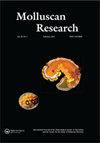The abundance, distribution and diversity of invasive and indigenous freshwater snails in a section of the Ogunpa River, southwest Nigeria
IF 0.6
4区 生物学
Q3 ZOOLOGY
引用次数: 5
Abstract
ABSTRACT This study investigated the abundance, distribution and diversity of freshwater snails at four sites in the Ogunpa River, Nigeria from May 2018 to December 2018. A total of 2067 freshwater snails was collected, belonging to two sub-classes, four families, and seven species: Physella acuta, Amerianna carinata, Melanoides tuberculata, Physa waterloti, Bulinus globosus, Bulinus senegalensis, and Lymnaea natalensis. Invasive freshwater snails (82.15%) were more abundant than indigenous species (17.85%). Physella acuta (30.05%) and P. waterloti (20.61%) were the most abundant species, while B. globosus (4.35%) and B. senegalensis (3.92%) were the least abundant. The presence of P. acuta, B. globosus, B. senegalensis, and M. tuberculata constitute potential economic and health risks to animals and humans in contact with this waterbody. Freshwater snail numbers showed variation among sites, seasons, and site-season interactions. Water depth, turbidity, and pH correlated significantly with the numbers of freshwater snails, except that pH did not correlate with P. waterloti. There were strong positive correlations between the numbers of molluscs and the abundance of Commelina diffusa, Amaranthus spinosus, Murdannia nudiflora, and Ipomoea aquatica. Stepwise multiple regression showed that water depth, C. diffusa, and Sacciolepis africana were the primary variables affecting snail distribution and abundance in the Ogunpa River.尼日利亚西南部奥贡帕河一段入侵和本地淡水蜗牛的丰度、分布和多样性
摘要本研究于2018年5月至2018年12月在尼日利亚奥贡帕河的四个地点调查了淡水蜗牛的丰度、分布和多样性。共收集到2067只淡水蜗牛,分为两个亚纲、四个科和七个物种:尖腹蜗牛、隆胸蜗牛、结节黑蜗牛、水蜗牛、球蜗牛、塞内加尔蜗牛和纳氏Lymnaea natalensis。入侵淡水蜗牛(82.15%)比本土物种(17.85%)更为丰富,其中尖绒蜗牛(30.05%)和水蜗牛(20.61%)最为丰富,球蜗牛(4.35%)和塞内加尔蜗牛(3.92%)最少。尖尖假单胞菌、球形芽孢杆菌、塞内加尔芽孢杆菌和结核分枝杆菌的存在对接触该水体的动物和人类构成潜在的经济和健康风险。淡水蜗牛的数量显示出不同地点、季节和地点-季节相互作用的变化。水深、浊度和pH值与淡水蜗牛的数量显著相关,但pH值与水蜗牛的数量无关。软体动物的数量与鸭舌草、刺苋、裸花和水藻的丰度呈正相关。逐步多元回归分析表明,水深、C.diffusa和Sacciolepis africana是影响奥贡帕河蜗牛分布和丰度的主要变量。
本文章由计算机程序翻译,如有差异,请以英文原文为准。
求助全文
约1分钟内获得全文
求助全文
来源期刊

Molluscan Research
生物-动物学
CiteScore
1.80
自引率
10.00%
发文量
27
审稿时长
>12 weeks
期刊介绍:
Molluscan Research is an international journal for the publication of authoritative papers and review articles on all aspects of molluscan research, including biology, systematics, morphology, physiology, ecology, conservation, biogeography, genetics, molecular biology and palaeontology.
While the scope of the journal is worldwide, there is emphasis on studies relating to Australasia and the Indo-west Pacific, including East and South East Asia. The journal’s scope includes revisionary papers, monographs, reviews, theoretical papers and briefer communications. Monographic studies of up to 73 printed pages may also be considered.
The journal has been published since 1957 (as the Journal of the Malacological Society of Australia until 1993). It is free to members of the Malacological Society of Australasia and the Society for the Study of Molluscan Diversity.
 求助内容:
求助内容: 应助结果提醒方式:
应助结果提醒方式:


